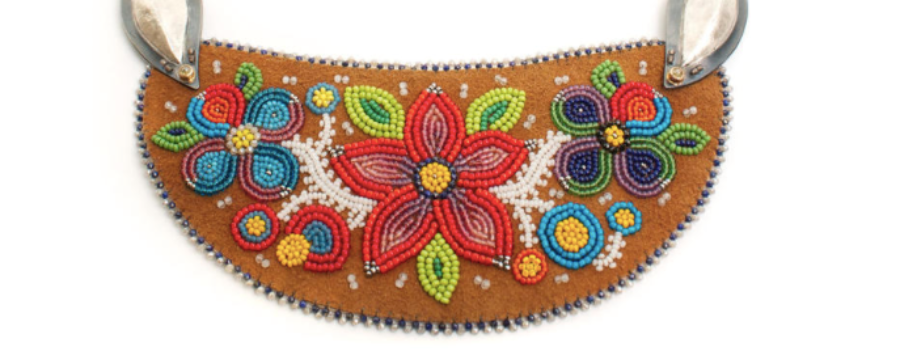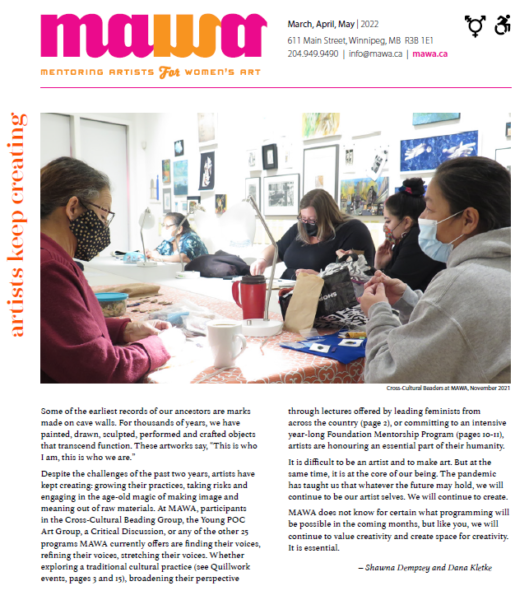
Here’s a letter for you, because I’m weary (and wary) of the arid, authoritative tone of art writing. Life is hard, at the moment. But the natural world consoles. Thinking about art consoles, too. Is there anything better than tracing a created object back to its roots – asking what need or desire, what collision of influences helped unfold this or that idea, compelled this or that object into existence?
In the north, these two consolations are closely linked. They depend upon each other, often inversely. Dene land is vast, stark, untamed. Dene beadwork – flowers most frequently – is a perfectly cultivated, neat-as-a-pin garden, entirely precise and controlled.
Gwich’in-Swedish artist Tania Larsson makes jewellery and adornments. She tells beautiful, complicated stories about beading history – beautiful because it is easy to imagine the tiny multicoloured globes glistening in the palms of those first beaders, complicated because they were trade-beads, a colonial tool. But beauty was insisted upon, she says. Long before contact, “We took so much time to adorn ourselves. All of our clothing was decorated with quills. So much love and care was given to garments.”
Larsson is also a hide tanner, one of several young artists based in Yellowknife who are working to revitalize the practice. I’ve watched dense clumps of moose hair tumble from the edge of their knife-blades. I’ve smelled the putrefaction and rotting flesh and the clean, fresh-wind scent of spruce boughs laid on the ground where they scrape and scrape and scrape at layers of tissue and skin – the aim, again, is perfection. Perhaps the most intoxicating scent in the world is the smell of smoke-drenched hide.
Intoxicating, but almost quotidian. In the north, Dene art lives in the everyday. I was given a beaded moose-hide cardholder for Christmas. I press it to my nose and breathe in that delicious smokiness. There are cardholders for ID and credit cards in half the back pockets in town. Beaded flowers appear in every grocery-store check-out line, in every Walmart transaction, a little bouquet for buying milk, diapers, bread.
In Yellowknife, the Walmart parking lot is haunted by ravens. There are bushes nearby that collect liquor bottles, wind-swept Covid masks, and the occasional shelter-seeking ptarmigan. Foxes lie under the parked cars and wait. The natural world – that realer world – is just around the corner. The wilderness starts at the end of the block. The northern lights outshine the streetlights. The stars – we know them like neighbours. I once drove past a house at night just as its garage door slid open, revealing the magnificent body of a wolf hanging from the ceiling. It is possible, in the north, to feel how life is supposed to feel; bloody, smoky. The land alive, the air spruce-scented.
How can we look at Dene art and craft without considering how alive it is? Fish eat other fish! I once saw a burbot sliced open, to reveal another, partially digested, burbot inside. And inside that one – yet another even smaller burbot. Yep, like those Russian nesting dolls. A four-pound creature scaling down to a tiny silver dash, the merest sardine.
Beading needles are brief silver dashes too – in and out, in and out, as if the hide offers no resistance. Have you ever watched an expert beader pick up beads with the tip of their needle? A flurry of silver and the task is done.
Larsson speaks about deft movements, the squinting required, precision. “I am giving myself liberties,” she says, “to work with perfectly imperfect beads, beads with personality.” She collects antique beads, preferring them to the factory-made because of their irregularities. There is the sense, too, that she’s re-claiming colonial beads. “I want to use the same beads my ancestors used.”
Larsson uses the skin of the animal, the brain, and a leg bone to make brain-tanned hides. She uses horns, antlers, shells, precious stones – all miraculous materials when you know even a little about Dene land. But she uses projections and digital imagery, too. Recently, she and artists Melaw Nakehk’o, Casey Koyczan and Davis Heslep created an installation called Moose Hide Dome. They stretched hide over a structure made from 40 triangular wooden frames, lighting it from the inside with projected footage of a hide-tanning camp in the community of Lutselk'e, N.W.T. I can’t remember an instance where past and future, material and immaterial, coalesced so simply and beautifully.
Larsson’s Indigenous audiences, she says, will feel a connection to her work through blood-memory, but she wants everyone to smell the hide, watch light glancing off the surfaces of beads and bone. If we can’t get to the end of the block, she wants us to know a little northern consolation, too.
Sincerely,
Sarah
Yellowknife, NT is located in Denendeh, the land of the Dene. The people of the Dene First Nations have been here for millennia.
To learn about Tania Larsson, please visit tanialarsson.com
Sarah Swan is a Yellowknife-based art writer, originally from Winnipeg.

